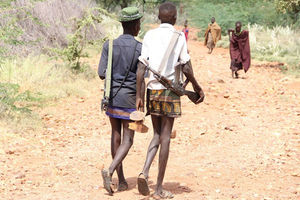
Members of the public at a security meeting at Kalya at the border of West Pokot and Elgeyo Marakwet counties.
In their search for wealth and power, bandits and livestock thieves are responsible for the death of more than 300 people, injuring thousands and destroying property worth millions of shillings in their raids across several counties since 2023, a new study has established.
This report, “Managing the Dangerous Drift in Livestock Rustling and Banditry in Kenya,” prepared by the National Crime Research Centre (NCRC), shows that there is a collapse or diminishing value for human life with the new wave of banditry and stock theft resulting in more recent deaths compared to the past.
The study was conducted in 13 counties of Baringo, Elgeyo Marakwet, Isiolo, Kitui, Laikipia, Marsabit, Meru, Samburu, Turkana, West Pokot, Tana River, Kisumu and Nandi.
Each county was found to have a unique set of challenges affecting it with regards to the menace posed by banditry and livestock rustling.
These vices continue to affect millions of Kenyans mostly living in the Northern arid and semi-arid regions despite billions of shillings being allocated by the government to deal with them.
From culture to crime
Unlike the past where the driving motive for the livestock theft was largely “an organised cultural sport”, the commercialisation of the practice has turned it into an “organised crime,” the report notes.
There is also the proliferation of illegal small arms and light weapons, which coupled with high levels of ignorance, illiteracy among the youthful population in the pastoralist regions, economic and poverty vulnerability, only serve to exacerbate the already lethal situation in the affected counties.
“The leading providers of firearms used during livestock rustling and banditry attacks were reported to be Kenya’s cross-border suppliers of firearms, followed by local business persons and politicians,” the study says.
Largely, the persistent cases of banditry and livestock rustling have been blamed on corruption and lack of integrity among some rogue public officials.
The Regional Centre on Small Arms attributes the flow of illicit small arms and light weapons from the neighbouring countries to corruption among border policing agents.
Corrupt officers
Corrupt security officials are also accused of abetting the crime by “leasing out their weapons to the livestock rustlers, with the Kenyan and Ethiopian military and police officers specifically being accused of lending out their weapons to warriors for raiding purposes,” part of the report states.
This, the officers do with the aim of making quick money for themselves by using their legally acquired firearms as is the case for some National Police Reservists (NPRs) deployed to these areas as the first line of defence in countering the bandits and rustlers.
“The NPRs have also been blamed in some instances for being compromised and misusing firearms to commit crime or even in some instances using the legally issued firearm to gain money through escort and guarding services, sometimes leading to the haphazard withdrawal of their firearms without adequate consultations thus compromising the services they offer,” the report showed.
The proliferation of illegal small arms was, however, not found to be a driver in Kisumu and Nandi counties.
Adoption of technology has also changed the tides for the criminals who now use their mobile phones to organise and conduct raids and destruction of built infrastructure including schools and houses.
There is also the use of livestock rustling and banditry as a tool for politicisation of territorial or land disputes as well as political competition and supremacy.
Community elders, once revered for their wisdom, are now entangled in the web of crime. They not only provide guidance and support to the rustlers but also participate in cleansing ceremonies and at times even assist in the concealment of stolen cattle.
Rogue elders
Further, the elders in the community, the study showed, act as seers for the livestock raiders, offering routes for smuggling, transporting and hiding/concealing firearms for the livestock rustlers and bandits as well as facilitation and administration of oath to the youthful livestock raiders
In some instances, the youth choose not to listen to the sober elders who caution them against meting out violence and/or getting involved in the livestock raids.
Community warriors, previously respected for protecting their communities from harm, are now front runners in the dangerous escapades and at 88 percent, present the majority of those who execute the livestock rustling and banditry.
“They are also crucial in spying the target areas, offering security/protection to fellow rustlers and bandits and the community against revenge as well as the recruitment and training of new warriors,”
Traditionally, it was common practice for the attackers not to harm or injure the vulnerable in the community, but nowadays, this caution has been thrown to the winds with increased cases of aggression directed towards women and children.
The direction of violence against women is, however, not without reason with the NCRC noting that there is an “increased role of women in the perpetration of livestock rustling and banditry and use of such raids to contest against government programmes”.
Women, the study showed, engage in several activities that promote the welfare of the raiders. These include hero worship and/or cherishing of successful youthful livestock rustlers and bandits through songs of praises.
“Cooking for the livestock rustlers and bandits, helping in hiding and/or moving stolen livestock and participating in the socialisation of children into livestock rustling and banditry,” NCRC stated.
As innocent as their faces might be, children are also in the heart of the chaotic raids that result in deaths and loss of property. They are crucial agents when it comes to hiding and/or moving stolen livestock, conducting actual raiding of livestock and spying the target areas on behalf of the livestock rustlers and bandits.
In short, this once revered traditional role of livestock rustling that is now evolving into something far more sinister, blurring the lines between ancient customs and modern criminality is slowly but surely pulling everyone into its web.
County-disaggregated data also showed that an inadequately regulated market for livestock-related products was a major driver of livestock rustling and banditry in all counties except in Nandi, Tana River, Kitui, and Turkana.
On the other hand, cycles of revenge were a major factor for livestock rustling and banditry in all the study counties except in Kisumu, Nandi, Baringo, Tana River and Meru.
In other countries apart from Kisumu, Nandi, Tana River, and Kitui, the raids were primarily fueled by the need to restock after loss of livestock during droughts.
Most sample respondents in all the counties except in Kisumu, Nandi, Tana River, Kitui and Turkana believed that livestock rustling.
Repeated failures
The inability of the government to curb this menace over years since independence has done nothing but to effectively erode the communities’ trust in the authorities as they witness repeated failures.
Barely two years ago, the Kenya National Union of Teachers sounded the alarm, that at least 50 schools were closed due to banditry in Kerio Valley.
Often, news headlines indicate just how bold the bandits and livestock rustlers have grown over years with every raid conducted proving more lethal than their previous ones. Pictures of homes razed to the ground, scared people hurriedly parking their luggage and leaving the only places heading to unknown places are now common. Incidents of deaths keep piling too.
But the fight against banditry has not been an easy one, even on the security agencies. In 2022, the National Police Service revealed that 82 security personnel lost their lives in the hands of bandits between 2012 and 2022.
In March 2024, Interior Cabinet Secretary Kithure Kindiki unveiled new equipment worth Sh7.6 billion to be used in the fight against organised crime, particularly terrorism and banditry.
Complete suppression
Prof Kindiki said the government is focused on complete suppression and neutralisation of terrorism, banditry, livestock rustling and other organised criminal activities to put Kenya on a firm path to equitable development and shared prosperity.
The equipment also included kitting of frontline officers deployed in Forward Operating Bases in Northeastern region, the Boni enclave, Upper Eastern region and North Rift.
The Interior Ministry boss also revealed that the government will spend another Sh29.4 billion in the next three years under the Police Equipment Modernisation (PEM) programme to acquire sophisticated protective and mobility equipment.
These interventions have proved helpful with several schools being reopened in the volatile counties of West Pokot and Baringo.
Just four days ago, police officers from Marich Police Station in West Pokot, together with the Anti-Stock Theft Unit and NPRs acted on a tip from locals and managed to recover 14 goats that had been stolen by bandits from Kainuk, in Turkana County. The bandits however managed to escape in the nearby bushes.
According to the NCRC study, banditry and livestock rustling has metamorphosed over time, with implications for change of tact in combating the present form of the menace.
Recommendations
The Centre has recommended enhanced climate-smart livestock-specific development programmes aimed at improving livestock health and survival in the pastoral cluster through enhanced livestock development extension services.
Other mitigations include improved security and regulation of the livestock sector, which is facilitated by well-established databases of livestock activities in the affected areas and line with the National Livestock Policy.
Instituting deliberate measures to address marginalisation and underdevelopment of pastoralist regions, especially through well-articulated County Integrated Development Plans (CIDPs), was also proposed.
Other recommendations include a deliberate programme for improved and incentivised access to literacy and formal education by the boy-child in pastoralist regions.
Reports show that the move will be a paradigm shift from a predominantly state-dominated security to a community security-based intervention and approach founded on the Community Asset Management principles that emphasize building and enhancing collaboration, and an enhanced programme for building and strengthening Kenya’s national conscience and ethos in the pastoralist regions.









